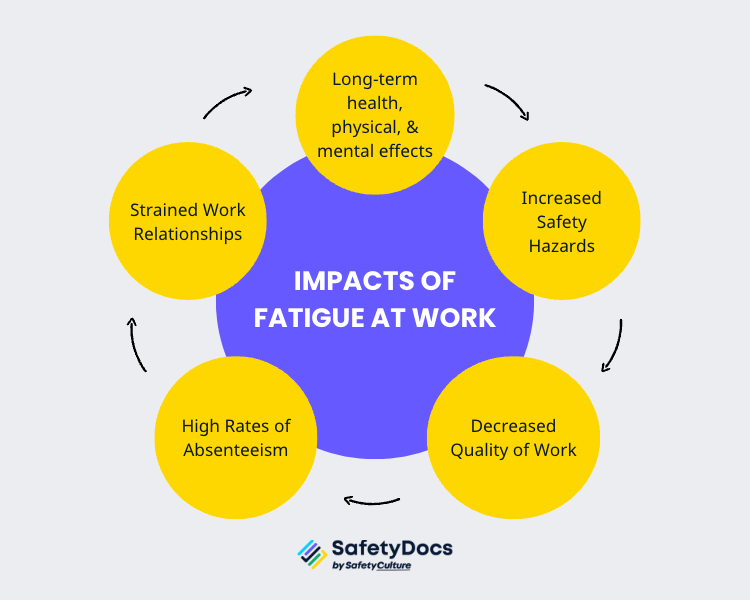Workplace fatigue is an often overlooked but severe issue that can significantly impact worker safety and productivity. According to a study conducted by Monash University, fatigue-related diminished alertness contributes to nearly 10,000 severe workplace injuries in Australia each year. This figure underscores the critical need for effective strategies to manage and mitigate fatigue in the workplace.
This article will delve into some practical measures businesses can implement to combat workplace fatigue, aiming to create a safer, healthier, and more productive working environment. Let's explore how we can address this prevalent issue head-on to implement effective control measures to ensure not only our employees' well-being but also our organisations' overall success.
What is Fatigue at Work?
Fatigue at work, often called workplace fatigue, is a state of exhaustion caused by various factors such as prolonged mental or physical exertion, insufficient rest, high-stress levels, or long working hours. It can manifest physically, mentally, or a combination of both, leading to decreased performance and productivity.
Physically, it may present as chronic tiredness, decreased energy, slower reaction times, or reduced strength and coordination. Mentally, it can result in a lack of concentration, impaired decision-making abilities, memory lapses, and decreased alertness.
Workplace fatigue can significantly impact an individual's health and well-being, increase the risk of accidents and injuries, and affect overall job performance. It is a critical issue that requires adequate attention and proper management strategies in the workplace.
Causes
The causes of workplace fatigue can be a multitude of factors. These factors often interplay, creating a complex web that, if not appropriately addressed, can lead to chronic physical exhaustion that reduces productivity. Here are some common causes in more detail:
- Excessive Work Hours: One of the most prevalent causes of workplace fatigue is working excessively long hours without adequate breaks or recovery time. This is particularly common in industries requiring shift work, such as healthcare, hospitality, or transportation. When an individual is required to work beyond their capacity, it can lead to physical and mental exhaustion.
- Insufficient Sleep: Not getting enough quality sleep is another significant contributor to fatigue. This could be due to irregular sleep schedules, sleep disorders like insomnia or sleep apnea, or insufficient time to rest properly. Sleep is essential for the body and mind to recover from the day's activities, and a lack of it can result in persistent fatigue.
- High-Stress Levels: Chronic stress, whether work-related issues or personal circumstances, can drain a person's energy reserves, leading to constant fatigue. High-stress jobs, tight deadlines, workplace conflicts, job insecurity, or high-responsibility roles can increase stress levels.
- Physically Demanding Work: Jobs that require intense physical activity or heavy manual labour can cause physical exhaustion. For instance, construction workers, factory workers, and agricultural workers are often exposed to strenuous physical tasks that can result in physical fatigue.
- Mentally or Emotionally Demanding Work: Jobs requiring constant decision-making, problem-solving, or high concentration levels can lead to mental fatigue. Similarly, roles that involve handling emotional stress, like social workers or therapists, can experience emotional fatigue.
- Poor Nutrition: A diet lacking essential nutrients can lead to low energy levels and fatigue. Consuming processed foods, sugary drinks, and unhealthy snacks instead of balanced meals can deprive the body of the necessary fuel to function optimally.
- Dehydration: Water is crucial in various bodily functions, including energy production. Inadequate water intake can lead to dehydration, which can cause feelings of tiredness and fatigue.
- Medical Conditions: Certain health conditions like anemia, diabetes, thyroid issues, heart disease, and mental health disorders like depression can cause or exacerbate fatigue. It's essential for individuals experiencing persistent fatigue to seek medical advice to rule out underlying health problems.
- Lack of Physical Activity: While it may seem counterintuitive, regular physical activity boosts energy levels. A sedentary lifestyle, every day in desk jobs, can contribute to feelings of fatigue.
- Monotonous Tasks: Engaging in repetitive or unstimulating tasks can lead to mental fatigue. Lack of variety or stimulation at work can make tasks seem more laborious, draining energy levels.
Signs and Symptoms
Recognising the signs and symptoms of workplace fatigue is crucial for early intervention and prevention. There are three categories of fatigue signs and symptoms to look out for — physical, cognitive, and behavioural indicators. Here are some common indications that an individual may be experiencing fatigue at work:
Physical Indicators
- Chronic Tiredness or Sleepiness: An individual feeling constantly tired or sleepy during work hours, despite getting adequate sleep
- Decreased Energy Levels: A noticeable decline in energy, resulting in slower movement or lethargy
- Frequent Yawning or Sighing: These could be the body's attempts to take in more oxygen due to feeling tired
- Headaches: Regular headaches, especially in the afternoon
- Dizziness: Feeling lightheaded or unsteady
Mental and Emotional indicators
- Decreased Concentration: Difficulty focusing on tasks at hand or being easily distracted
- Impaired Decision-Making Abilities: Making errors in judgement, taking longer to make decisions, or avoiding decision-making
- Memory Lapses: Forgetting important information, tasks, or meetings
- Decreased Alertness or Slower Reaction Times: This could lead to an increased risk of incidents or mistakes at work
- Mood Changes: Increased irritability, impatience, or lower tolerance levels
- Reduced Motivation or Commitment: A lack of interest in work or a drop in performance levels
Who is at High-risk of Getting Workplace Fatigue?
Certain groups of workers are at a higher risk of fatigue due to the nature of their jobs or working conditions. These include:
- Shift Workers: Those who work night shifts, rotating shifts, or irregular schedules often struggle with sleep disturbances and disruptions to their circadian rhythm, making them highly susceptible to fatigue. Examples include healthcare workers, transportation staff, and security personnel.
- Long-Hour Workers: Employees who work long hours, overtime, or have multiple jobs have less time to rest and recover, increasing their risk of fatigue.
- High-Stress Job Holders: Individuals in high-stress roles, such as healthcare professionals, law enforcement officers, emergency responders, and teachers, typically face mental and physical demands that can lead to fatigue.
- Physically Demanding Job Workers: Those in occupations requiring heavy manual labour, such as construction, manufacturing, or agriculture, are at higher health and safety risks due to the physical exhaustion associated with their work.
- Transportation Industry Workers: Drivers, pilots, and other transportation operators often have irregular schedules and high safety responsibilities, placing them at elevated work-related fatigue.
- Healthcare Workers: Long shifts, night shifts, and the emotional and physical demands of caring for patients put healthcare workers like doctors, nurses, and paramedics at high risk.
- Office Workers: While it might seem counterintuitive, they are also at risk. Sedentary work, long hours in front of a computer screen, and mental strain can all contribute to fatigue.
- Workers in High-Risk Industries: Employees in mining, oil and gas, and utilities often work in hazardous conditions and for extended hours, increasing their fatigue risk.
- On-call and call-back workers: Those who work on-call or are subject to call-backs during off hours have their sleep cycles disrupted, which can lead to fatigue. Examples include IT staff and firefighters.
Despite these groups being at higher risk of fatigue, anyone can experience it due to inadequate rest or other health and lifestyle factors. Awareness of the signs and symptoms is essential for early intervention and prevention.
Impacts of Fatigue at Work
Increased safety hazards
Fatigue can increase the likelihood of workplace accidents and injuries. Sleepiness and reduced alertness can cause employees to overlook potential hazards, react slowly to emergencies, or underestimate health and safety risks. Manufacturing, construction, and transportation industries are particularly vulnerable to fatigue-related safety hazards.
Decreased quality of work
Fatigue can result in reduced productivity, inefficient performance, and an overall drop in quality of work. Attention to detail may suffer due to mental lapses, and decision-making abilities can be impaired, leading to errors in judgement. Additionally, fatigued employees often need more motivation and enthusiasm to do their job well.
High rates of absenteeism
Fatigue can lead to higher rates of absenteeism, as employees may be more likely to take days off due to feeling unwell or needing additional rest. This can have a significant impact on work performance, as well as the morale of other employees who are left to pick up the slack.
Strained work relationships
Fatigue can affect interpersonal relationships in the workplace. Employees may become irritable, less patient, and need help communicating effectively. This can lead to conflicts, strained work relationships, and reduced collaboration among team members.
Long-term health, physical, and mental effects
Chronic fatigue can have serious long-term effects on an employee's health. Prolonged exhaustion can lead to physical and psychological issues, such as depression, anxiety, weakened immune system, and cardiovascular problems.
The key to avoiding and managing workplace fatigue is prevention. But who is responsible for taking preventive measures?
WHS Duties in Fatigue Management
Persons conducting a business or undertaking (PCBU)
As per the Guide for Managing the Risk of Fatigue at Work by SafeWork Australia, the person conducting a business or undertaking is responsible for reasonably ensuring the health and safety of workers and others involved. This includes:
- Maintaining a safe work environment
- Implementing safe work systems
- Monitoring worker health and workplace conditions to prevent illness or injury
- Engage in discussions about health and safety with employees and HSRs, if applicable
- Collaborate and coordinate activities with other duty-holders
- Document safety efforts and any related reports or decisions
Health and Safety Officers
Company directors and similar officers must employ due diligence to ensure their business or enterprise meets its work health and safety responsibilities. This includes acquiring and keeping up-to-date knowledge of WHS matters, consulting with workers, and ensuring that the business or enterprise uses all systems to handle work related fatigue other-related risks.
Workers
As a worker, your top priority is always to ensure your health and safety, as well as the health and safety of your colleagues. You must adhere to appropriate directives and cooperate with any practical policies or procedures related to managing fatigue in the workplace. Doing so can help prevent any negative impacts on your performance or the well-being of yourself and others.

Risk Management Process
To effectively manage fatigue in the workplace, employers should have a comprehensive fatigue risk management system in place. This includes:
- Identifying the hazards and determining any potential risks associated with them
- Assessing the level of risk posed by each hazard
- Implementing appropriate control measures to reduce and manage the risks
- Monitoring the effectiveness of these control measures
- Reviewing and revising the system as necessary
Identifying Hazards and Assessing Risks
Hazards can be identified through various methods, such as:
- Consultation: Engage with workers, managers, supervisors, and health and safety representatives to understand their perspectives and experiences. For instance, discussing the impact of workload, work schedules, work-related travel, and work conducted outside regular hours can reveal potential hazards.
- Observation: Inspect work practices, systems of work, and worker records closely. Records like sign-in and sign-out sheets can provide insights into irregular patterns or issues that may indicate a hazard.
- Data Review: Analysing data from different sources can also be beneficial. Workplace incident reports, or human resource data, can help identify patterns or recurring issues that point to an underlying hazard.
Once you have identified the hazards, the next step is to assess the associated risks. Risk assessment involves determining the severity of the potential outcome, its likelihood, and the number of people it may affect. However, this step may be optional if you deal with a known risk with established controls. In such cases, implementing the known control measures should suffice.
Controlling Risks
Managing risks effectively is crucial for maintaining a safe and healthy workplace. If potential hazards cause fatigue, the first step is to eliminate these risks, if reasonably practicable. If not, efforts should be made to minimise the other fatigue risk factors as far as possible. Here are some examples of control measures that can be used to manage the risks of fatigue:
- Work Scheduling: Plan work schedules strategically to avoid safety-critical tasks during low body clock periods. These are periods when the human body naturally experiences decreased alertness and performance.
- Modifying Shift Work and Rosters: Restrict the number of consecutive night shifts to prevent excessive tiredness.
- Managing Job Demands: Structure the shifts such that the work demands peak mid-shift and decrease towards the end. This approach aligns with the natural energy levels of workers, reducing the risk of fatigue towards the end of the shift.
- Changing Environmental Conditions: Eliminate working in physically strenuous conditions, such as extreme heat.
- Consulting Workers: Engage with workers to manage non-work-related causes of fatigue. This could involve discussions about lifestyle factors like sleep habits and physical health.
- Implementing a Workplace Fatigue Policy: A comprehensive fatigue management policy can include provisions for regular breaks, maximum shift lengths, and procedures for reporting fatigue-related concerns.
Reviewing Hazards and Control Measures
After implementing control measures to manage fatigue risks, monitoring and reviewing these measures is essential to ensure they remain effective. Here are some steps for reviewing hazards and control measures:
- Regular Monitoring: Look for signs of fatigue among employees, check adherence to new work schedules, and observe for any changes in the working environment.
- Trial Periods: This allows you to assess their effectiveness and make necessary adjustments before fully integrating them into the workplace.
- Worker Feedback: Employees can offer valuable insights into whether the measures are reducing fatigue and if there are any unforeseen issues.
- Data Analysis: Analyse data from various sources such as incident reports, worker feedback, and health and safety records
- Review and Update: Based on your findings from monitoring, feedback, and data analysis, review and update the control measures as needed.
Providing Information, Instruction, Training, and Supervision
One of the most effective ways to manage fatigue and its associated health risks while in the workplace is through education and training. Here are some key points to consider:
- Information: Provide clear, accessible information about the causes of fatigue and its potential impact on health and safety. This could include written materials, presentations, or online resources.
- Instruction: This involves guidance on proper work scheduling, taking regular breaks, or following a specific workplace fatigue policy.
- Training: Training cover topics such as recognising signs of fatigue, understanding the impact of fatigue on work performance and safety, and practical strategies for managing fatigue.
- Supervision: Supervisors play an essential role in monitoring employee fatigue. They should be trained to recognise signs of fatigue and take necessary steps to reduce the risks of fatigue-related accidents and incidents.
- Availability: Arrange training sessions to ensure availability to all workers across all shifts. Regardless of their role or shift, everyone in the organisation should have access to the same level of information and training.
SafetyDocs for Effective Fatigue Management
Effectively managing fatigue in the workplace requires a comprehensive approach. You need to be able to identify and assess the risks, implement control measures, monitor their effectiveness, and provide information and training. Safetydocs by SafetyCulture can help you do this efficiently and systematically.
We provide various resources to support and enhance your existing safety program. Our safety documents guide risk assessments, hazard identification safety procedures, control measures, management plans, and more. Our customisable templates make it easy to create and maintain fatigue risk management approaches and systems that help ensure a safe and healthy working environment.
Start with these safety documents to get started with effective fatigue risk management strategies:
- Workplace Fatigue Risk Assessment Form
- Workplace Fatigue Management Plan
- Light Vehicle Driver Fatigue Management Form
- Psychosocial Hazards Management Plan
Contact us to learn more about how SafetyDocs can help you manage fatigue and its associated risks in the workplace.
Our team of experts is dedicated to providing accurate and informative content. Craig Cruickshank, our senior HSEQ advisor at SafetyDocs by SafetyCulture has reviewed this blog post to ensure the highest level of quality.
Learn more about Craig's work on LinkedIn for more industry insights.
Available for instant download and supplied in fully editable MS Word format for use in your business.
Please note that the above information is provided as a comment only and should not be relied on as professional, legal or financial advice.
Share This Article


